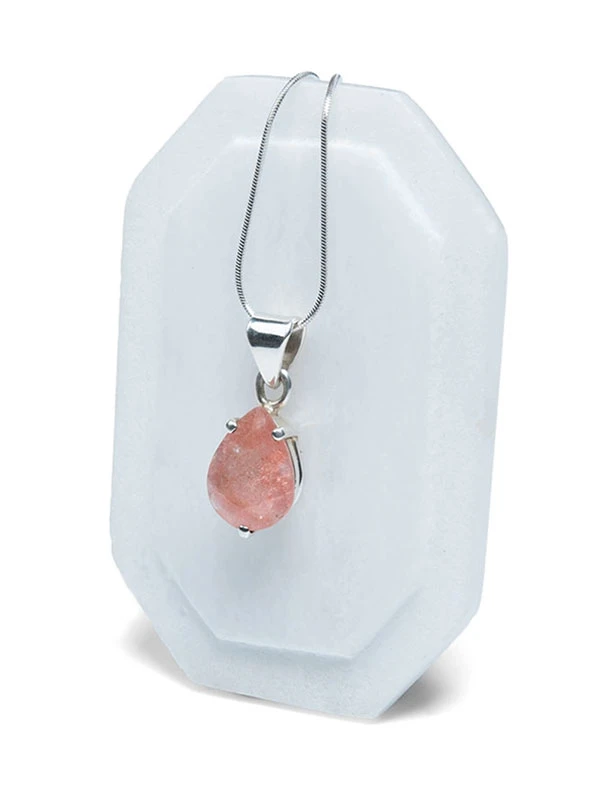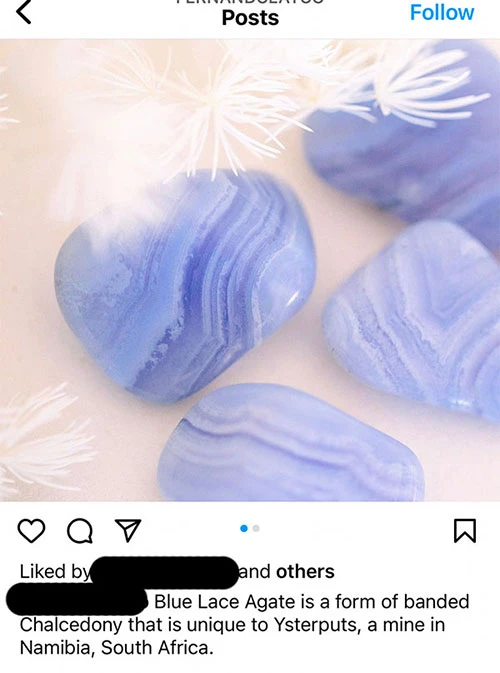Fake Crystals: What to Look Out For

Don't Get Scammed When Shopping for Crystals
It's easy to get scammed when buying crystals online. Fake crystals, which include those imitated using a different natural stone, have been around for thousands of years.
A manufacturer usually produces a fake product to meet high demand, especially for something rare or in short supply. Imitations and fakes can be sold for a lower price, allowing the seller to make a profit while offering a cheaper alternative.
Generally speaking, imitation and fake are not the same. People who buy imitations do so in the knowledge of what they're buying. These products don't tend to be produced to deceive people into believing they're buying the real thing.
With regard to rocks and minerals, imitation pearls and opals are good examples.
Many people buy products knowing they're fake, which is fine if that's what they want to do. It only becomes a problem when something is sold with the intention of deceiving or defrauding someone into believing it's genuine.
Although fake products are often sold at a lower price, they can also be sold at the same price and, in some cases, are even more expensive than the genuine item.
Fake stones are often made from synthetic materials such as glass, resin or plastic. They can also be produced by dyeing cheaper, more readily available minerals. 
Mineral Manipulation: The Art of Deception
Howlite (pictured above), which can be white or grey, is often used for fake turquoise. Its dark-coloured veins make it a popular choice because they're difficult to reproduce in a synthetic material.
Another crystal that's often fake is quartz. Many crystal balls are made of glass or lead crystal. Lead crystal is glass infused with lead, which enhances its optical properties. Lead is added during manufacturing to increase the refractive index, which makes the glass more reflective and sparkly.
The more lead that's added, the greater the brilliance and clarity.  The crystal balls in these photos are being sold in an online marketplace. The iridescence in quartz comes from the interference of light as it passes through the crystal.
The crystal balls in these photos are being sold in an online marketplace. The iridescence in quartz comes from the interference of light as it passes through the crystal.
Interference occurs when light waves interact with each other as they enter a crystal and bounce around inside. Refraction and dispersion also contribute to the rainbows that can be seen.
The colour in these crystal balls is not being produced naturally. When a thin layer of titanium dioxide is applied to a surface, it creates an iridescent effect because of its ability to interact with light.
These crystal balls are being sold by a Chinese business, but I've also seen them being sold by sellers in the UK and U.S.A.
On one website I visited, the owner states they only buy crystals that have been ethically and sustainably sourced. Yet they've bought crystal balls, probably unknowingly, that have been coated to produce iridescence. And there's a good chance they may not even be quartz.
These two quartz crystal balls are from our collection.
![]() (*)
(*)
The gemstone in this next photo is being sold as 'natural' lemon quartz, but lemon quartz doesn't occur naturally. It's produced by irradiating and heat-treating colourless quartz or pale amethyst.
Labelling it as 'natural' demonstrates that the seller is either unaware that it doesn't occur naturally or is not being honest. That said, mislabeling a stone that's been heated to alter its colour is not the same as selling something fake.
Heat treatments, which are a commonly accepted practice, are generally considered to be an enhancement. Therefore, it's not deception to call this stone lemon quartz, but it is when you call it 'natural' lemon quartz. This citrine geode is being sold by another online business. On their website, they state they travel the world in search of the finest minerals and gemstones.
This citrine geode is being sold by another online business. On their website, they state they travel the world in search of the finest minerals and gemstones.
Natural citrine rarely occurs as a geode. One article I read on what appeared to be a trustworthy geology-related website spoke in great detail about citrine geodes, yet the geodes in their photos were all heated amethyst.
Burnt orange-coloured crystals are a dead giveaway.
Almost all citrine geodes and certainly large pieces like this are heated amethyst. Calling this geode citrine is widely accepted, but labelling it as 'natural' citrine raises serious questions. Three factors impact the accuracy of information published about crystals, rocks, and minerals. The first is a business's lack of expertise or knowledge, which can lead to a misunderstanding about the material being sold.
Three factors impact the accuracy of information published about crystals, rocks, and minerals. The first is a business's lack of expertise or knowledge, which can lead to a misunderstanding about the material being sold.
The second relates to those who deliberately choose to deceive by providing false or misleading information. The third involves those who are blatantly fraudulent. These people are actively seeking to deceive and scam you.
They'll tell you their shungite is the finest grade when it's actually a rock that contains small amounts of shungite. They'll sell you lapis lazuli that's probably dyed sodalite, or fake turquoise that may be howlite or worse still, synthetic.
This is a good example of fake moldavite. It looks like green glass, but a more obvious clue is the price. If a piece of moldavite of this size were to be found, which would be highly unusual, it would sell for a serious amount of money.  Opalised fluorite is often sold as Tiffany Stone, but not all opalised fluorite is Tiffany Stone.
Opalised fluorite is often sold as Tiffany Stone, but not all opalised fluorite is Tiffany Stone.
Tiffany Stone is a rare variety of opalised fluorite found only in Utah, USA. The location where it's found has been closed for many years, making it difficult to source and highly sought after by collectors.
Heated amethyst is often sold as natural citrine. Smoky quartz is often clear quartz that's been heated. Black onyx is mostly dyed agate or chalcedony because natural black onyx is rare.
Most stones labelled 'onyx' are banded calcite because calcite is more readily available and cheaper. Calcite is also softer than onyx, making it easier to work with.
Lapis howlite doesn't exist. It's difficult to know whether these stones are howlite, but whatever they are, they're dyed. Howlite is not expensive, yet even after being reduced, these stones are still more expensive than our premium-grade lapis lazuli tumbled stones. Sadly, the internet is full of examples like this, and the problem has exploded in recent years because of the amount of merchandise coming in from China. Another contributing factor is that it's now so easy for anyone to sell online.
Sadly, the internet is full of examples like this, and the problem has exploded in recent years because of the amount of merchandise coming in from China. Another contributing factor is that it's now so easy for anyone to sell online.
Many small businesses buy directly from overseas suppliers, which can make effective communication difficult due to language and cultural differences. Furthermore, finding honest and trustworthy people to do business with is not easy.
These stones are not blue tigers eye. They look like brown tigers eye that's been dyed.
Navigating the Maze of Misinformation
A well-designed website can attract considerable traffic, but it can be difficult to establish who's behind it and whether the content is accurate.I recently discovered a website with hundreds of articles on a wide variety of subjects. Although some were accurate, many were not, particularly regarding rocks and minerals. One article discussed stones that can be submerged in water.

The sole purpose of the Mohs scale of mineral hardness is to measure the scratch resistance of one mineral against another. While it's true that many soft minerals do not react well to water, the reason is not because of their hardness.
Most inaccurate information published online comes about because of copying and republishing someone else's work, but there are several other reasons as well:
Lack of verification
Many people don't take the time to verify the accuracy of information before republishing it, which means more of the original content is likely to be lost each time.
Social Media
Information published on social media often aligns with someone's beliefs or biases, and posts often lack accuracy.
Clickbait
People who create content solely to improve engagement may exaggerate or distort information to make it more appealing.
Plagiarism
Google has been trying to stamp out plagiarism for years. Plagiarised content is usually rewritten to appear original, but because facts are often misunderstood or misinterpreted, articles often lose context, accuracy or both.
The following screenshots are from an article published by a U.S.-based business that appears on page one of Google when you search for "How to Identify Fake Crystals."
So much of what's said is inaccurate that it's difficult to know where to begin.

The scale is called the "Mohs" scale because it was named after Friedrich Mohs. 'Real crystals' do not score higher. Rocks and minerals are given a number according to their hardness.
Diamond, the hardest mineral, grades 10. The softest is talc, which grades 1. Gypsum grades 2 and calcite grades 3. These three soft minerals are all natural.
What the author says about how to tell whether a crystal is fake is also incorrect.
 While crystals with exotic names may raise suspicions of being fake, it's unreliable.
While crystals with exotic names may raise suspicions of being fake, it's unreliable.Spinels are found near San Carlos, Gila County, Arizona, so a stone mined there may be called 'Arizona Spinel.'
'Blue moonstone' is often used to describe moonstone with a blue hue. Moonstone is a natural gemstone. 'Longido ruby' is found in Longido, northern Tanzania.
Historically, many coloured, translucent gemstones were believed to be topaz. Only in the last two hundred years was it discovered that this was incorrect. Today, it's not uncommon for smoky quartz to be mislabelled as smoky topaz, but it's usually an innocent mistake caused by lack of knowledge.
 This natural Strawberry Quartz gemstone (from our collection) is from Kazakhstan. This type of quartz gets its pink to red colour from hematite inclusions or other pink or red-coloured minerals.
This natural Strawberry Quartz gemstone (from our collection) is from Kazakhstan. This type of quartz gets its pink to red colour from hematite inclusions or other pink or red-coloured minerals.Strawberry Quartz is quite rare, so many stones are fake.
The website this information came from has a vast reference section. In another article, they write that opalite is also known as opalised fluorite, ice cream opal, and Tiffany Stone.
Opalite and Tiffany Stone are two completely different materials. Opalised fluorite and ice cream opal are used, albeit incorrectly, as alternative names for Tiffany Stone.
On their product page for opalite they say, "This man-made version of opal is 100% natural. A one-of-a-kind stone with a letter of authenticity."
Opalite, which is glass, is manufactured mostly in China. A man-made material cannot be 100% natural. More worryingly, what does the letter of authenticity confirm, and who issued it?
This post from another crystal website says blue lace agate is unique to Ysterputs. Although the Ysterputs mine in southern Namibia is where blue lace agate was discovered, it can also be found in several other African countries.

A Final Thought...
Being able to spot a fake crystal, rock or mineral from a photo or when it’s in your hand can protect you from scams and boost your confidence as a collector.In my next article, I’ll share practical tips for identifying fakes, whether you’re suspicious about a recent purchase or eyeing something new.
You’ll find hands-on tests and smart ways to do research using trusted, free online resources. Plus, I’ll reveal how to spot businesses from India and China who want you to believe they’re in the UK or USA.
Article Photos
The rocks and minerals in the pop-up photos in this article are from our collection, except for the fake turquoise and malachite!

















